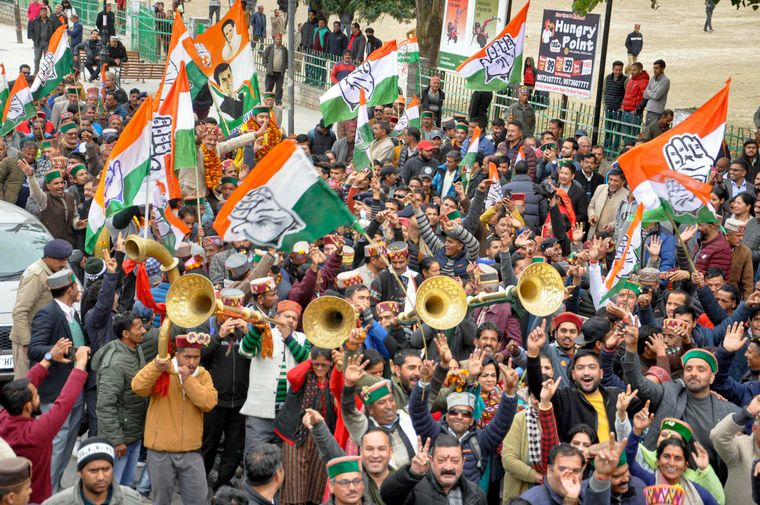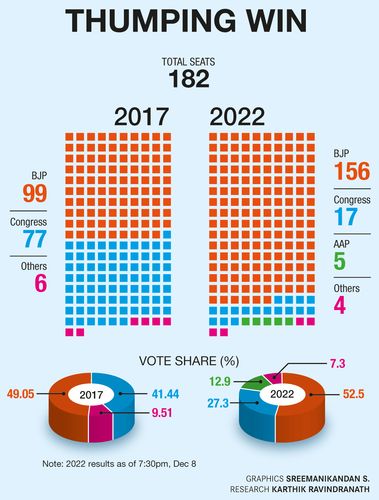GUJARAT AND HIMACHAL PRADESH voted for rivaaj (tradition). While Himachali voters rejected the BJP and upheld the tradition of electing an alternate government every five years, voters in Gujarat gave the saffron party its biggest victory ever and a seventh straight term. With over 52 per cent vote share, and 156 of 182 seats, the Modi magic has worked again in Gujarat, although he moved to Delhi eight years ago.
The Modi mantra of good governance, development and welfarism infused with the cultural resurgence of hindutva–known collectively as the Gujarat model–still pays dividends. For Prime Minister Narendra Modi and the BJP, 2022 is ending on a high note as they expect the momentum gained in successive victories in Uttar Pradesh, Uttarakhand, Goa, Manipur and Gujarat will be carried forward next year when elections will be held in ten states, including key ones like Madhya Pradesh, Rajasthan, Chhattisgarh, Karnataka and possibly Jammu and Kashmir. Winning Gujarat has been on expected lines, still, the historic mandate in their home state has come as a matter of personal satisfaction for Modi and Union Home Minister Amit Shah.
The cacophony of victory chants at the BJP headquarters may have drowned out the loss in Himachal Pradesh and the Aam Aadmi Party’s victory in the Delhi municipal elections, but the road ahead for the 2024 Lok Sabha polls is not devoid of challenges.
Voters appear to reward strong leadership and punish weak contenders―perhaps, a lesson for future electoral battles. Although Himachal Pradesh Chief Minister Jai Ram Thakur won his seat with a record 76 per cent votes, and got the BJP most seats in his home district, he was not seen as assertive leader in the rest of the state. In Gujarat, Bhupendra Patel, a first-time MLA chosen to replace Vijay Rupani, too, faced a similar challenge. But the Gujarat electorate voted for Modi’s charisma and Shah’s strategic acumen in the absence of any credible opposition. Similarly, in Delhi, the electorate gave the nod to the AAP which sought votes in the name of Chief Minister Arvind Kejriwal.
During the 2017 assembly polls in Gujarat, the BJP faced multiple challenges. Demonetisation, the introduction of GST and rising prices had disillusioned the trading community. The politically important Patel community was agitating for reservation. Moreover, Modi was more focused on Delhi, while Congress leader Rahul Gandhi undertook multiple tours, visited temples and even asserted his Brahmin heritage. People took notice of the challenger as he courageously took on Modi. However, certain comments by Congress leader Mani Shankar Aiyar gave the BJP a chance to regain lost ground, and the party managed to retain power with 99 seats, while the Congress won 77.
Since then, sources said, the BJP worked hard to remove the adverse factors. The 10 per cent reservation for economically weaker sections helped it win over the Patidars, as did the installation of a Patel chief minister. The BJP went on a door-to-door campaign, with Shah micromanaging electoral strategy. The party opened its doors to Patidar Congress leaders like Hardik Patel, OBC leader Alpesh Thakor and 19 Congress MLAs. The GST rates of several items were rationalised. The BJP had another constituency to address, which had historically been with the Congress―the tribals. Many of them were won over with the decision to nominate Droupadi Murmu as the first tribal president of India. When the votes were counted on December 8, the BJP won most of the seats in the Patel dominated Saurashtra and also in the tribal areas. While the Congress ran a low-key campaign, the BJP pumped in its star campaigners including Central ministers and several chief ministers to campaign across the state. It also pushed the hindutva agenda by promising the uniform civil code and giving ticket to the daughter of a Naroda Patiya riots convict. The decision to release convicts in the Bilkis Bano case was an attempt to polarise the campaign so that core BJP voters would step and vote. As it turned out, the 2022 verdict was even better than the 2002 verdict after the Gujarat riots when the BJP had won 127 seats.
Last year, the BJP experimented with changing chief ministers to beat anti-incumbency in Karnataka, Uttarakhand and Gujarat. But the Himachal chief minister was allowed to continue. The experiment worked in Uttarakhand where the BJP won, but the chief minister lost. It worked in Gujarat, too, where a first-time MLA was named chief minister and 40 MLAs were denied tickets. In Himachal Pradesh, however, ticket distribution led to much resentment and feud between various factions. The BJP, in fact, had 21 rebels contesting against the official candidates. “It is the biggest victory since independence in Gujarat,” said BJP president J.P. Nadda. “We lost in Himachal with a difference of less than one per cent vote.”
Unlike the previous elections, Gujarat did not see much polarisation this time, but the consolidation of the Hindu votes happened in the absence of any credible fight by the Congress. As the AAP debuted with nearly 13 per cent votes and five seats, the Congress vote share dropped by 14 per cent, leading to a loss of 60 seats from 2017.
Among the key messages from the Gujarat victory is the BJP’s focus on reserved seats in which the party did proper strategising and performed exceptionally well. “We won 34 of the 40 seats reserved for SCs and STs,” said Modi in his victory speech at the BJP headquarters.
Modi gave out a figure which holds an important lesson for parties across the political spectrum. “Over one crore voters, who have not witnessed the ills of previous Congress governments, voted in this election,” he said. “The youth are naturally inquisitive and they question everything. They have accepted the BJP’s governance model.”
Amidst the gloom in Gujarat and Delhi, Himachal remains the lone bright spot for the Congress. The state may be a political lightweight compared with other heartland states as it has only four Lok Sabha seats, yet it is a valuable addition for the Congress as the other two states where the party is in power―Chhattisgarh and Rajasthan―go to the polls next year.
This round of elections has brought the AAP into focus as they wrested the Delhi municipal corporation from the BJP, and managed a decent vote share in Gujarat, qualifying it to become a national party. “Not only has the AAP become a national party, it has also become a national alternative,” said AAP spokesperson Malwinder Kang. Being ideologically neutral, the AAP can easily fit anywhere which traditional parties like the Congress often find difficult.
Also read
- Modi magic dispels all obstacles to win Gujarat in style
- What led to Congress's decimation in Gujarat
- What can Congress learn from Gujarat loss and Himachal win
- In its local and state level endeavours, AAP aims to achieve its national ambition
- Himachal: 10 guarantees Congress gave to the voter that helped it win
- Exclusive: "We will bring honesty and transparency in Himachal Pradesh", says Sukhu
The little noticed results of byelections also point to changes on the ground. The ruling Janata Dal (United)-Rashtriya Janata Dal combine lost the Kurhani seat in Bihar, while in neighbouring Uttar Pradesh, the incumbent BJP suffered some reverses. The BJP lost the Khatuali seat which fell vacant after its sitting MLA was convicted in a riot case. Although the BJP gave the ticket to his wife, she lost to the opposition candidate. The BJP, however, managed to win Rampur, the pocket borough of Samajwadi Party leader Azam Khan. The Samajwadi Party retained the Mainpuri Lok Sabha seat which fell vacant after the death of party supremo Mulayam Singh Yadav. SP chief Akhilesh Yadav’s wife, Dimple Yadav, won the seat.
The results from Gujarat and Himachal Pradesh offer clues regarding the shape of things to come in the next 15 months before the Lok Sabha polls. The next budget will be Modi government’s last one before the polls. Finance Minister Nirmala Sitharaman will be under added pressure to present a growth oriented budget which will boost employment and address the youth and women voters. Next year will also witness India hosting the G20 summit, which gives Modi an opportunity to showcase himself before the world and his voters. But he will have a tough time keeping the young voters engaged as they may not remember the shortcomings of the previous regimes, which propelled him to power in 2014.




